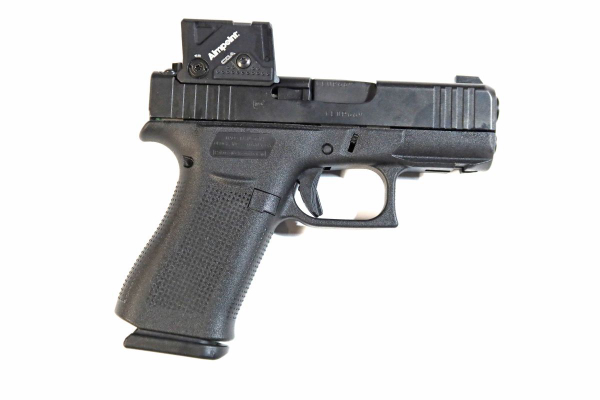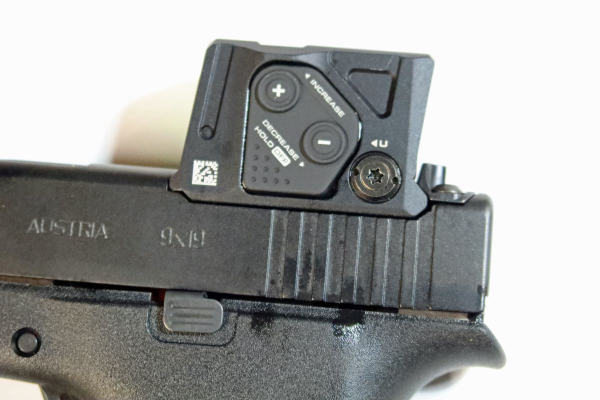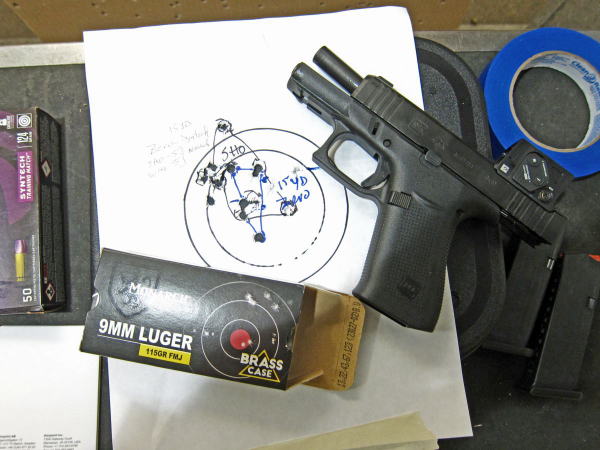Back in January, I scribbled a piece about changes to the mounting solutions for pistol-mounted optics. You can find it here.
One of those solutions was a cooperation between GLOCK and Aimpoint. For the first year of production, Aimpoint’s new COA enclosed-emitter pistol optic is supplied only on GLOCK pistols; mounted at the factory, there are no over-the-counter sales of the new glass.

The new G43X, above, was provided with the factory-installed Aimpoint COA enclosed-emitter optic. Below, the differences between the previous G43X (with tan TALON grip) and the new gun are few.
It wouldn’t matter if they did – the mounting solution is partly contained in the form of the optic housing. It noses into the front slide cut, drops into the slide cut and it’s retained by a non-optic rear sight that has a clamping ledge. It’s held on by a pair of screws of larger size than normally used to affix plates and sights. This now-proprietary system is GLOCK-only. I’d imagine other pistol-makers will be rolling their COA-cut pistols into production next year.
The advantage is that the recoil forces have an impact on the optics body and slide together without being concentrated on a pair of tiny screws.
The Aimpoint COA enclosed-emitter optic is factory-mounted to the following 9mm pistols: the G43X, G48, G19 Gen5, G45, and the G47. The optic is sold exclusively in this package and is not sold separately.
I have the G43X-COA here now. Anxious to shoot it, I made the trip to a nearby city to use an indoor range – as the trip to my club was made impassable since the recent blizzard.
The first order of business was to check the zero. I couldn’t find a way to zero from a seated rest without rounds traveling perilously close to the ceiling, so I fired singles standing off-hand at fifteen yards to check zero. This was the first five rounds fired out of the new optics-supplied gun from the factory.
I shot 124 grain Federal Syntech “Training Match” ammo. The group was an even two-inches, with the best three into an inch. All hits were inside the three-inch scoring circle – and nicely centered for elevation and windage.

The unique mounting arrangement appears to be rugged; time will tell. Below, the first five shots out of the gun – fired from 15 yards – are in the scoring circles. The slight tendency left notwithstanding, I made no adjustment to the optic.
I followed up at the same distance with ten rounds of Monarch 115gr. FMJ “Brass Case” ammo. The first five rounds I fired strong-hand only; the second string was non-dominant hand only. All hits were on the page with a single high flier just outside of the four-inch scoring ring. Two rounds hit inside that ring, with the remaining seven hits inside the 3” circle.
I posted a Birchwood Casey “EZE-Scorer” 12”x18” BC-IPSC Practice target and ran it back out to fifteen yards for a variation of the “Cirillo Drill,” explained by Claude Werner here.
The first six rounds of the drill were fired with the dominant hand, supported. From ready, that’s a single hit, followed by a pair from ready and ending with three hits from ready. After the reload, the last string of six rounds were fired from the nondominant side. All hits were nicely inside the “C” zone of the reduced silhouette, with the majority in the “A” zone. I loaded with Federal Syntech and fired the head-shot drill on the reduced silhouette.
Fired from seven yards, all hits were inside the reduced headbox. Moving it up to five yards, I repeated with five rounds of Monarch ball.

Shooting one handed, five rounds right and five rounds left, on the zero target with Monarch brass case ball, showed that the gun/optic could deliver the goods. Below, the results of the ‘head-shot’ drill, at five- and seven yards.
Thoughts thus far … Having an optic on such a small gun is not particularly new to me; I’ve been using a Springfield Armory Hellcat Pro for a few years now and it wears an optic. Still, that’s an increase on the size of the envelope that is likely really needed by few users.
The mounting arrangement is superb – thus far. I’d recommend adding a witness mark to each of the mounting screws, making it easier to check to ensure they’re locked and stable. You should do that on optics mounting hardware on all pistols and rifles, so that’s nothing new.
If you’re going to carry a pistol with a PMO, the closed emitter is likely the smart money. This is only the second one I’ve used and the protection the enclosed case provides seems worth it.
A difference between this G43X and the one I’ve been wearing on-and-off the past few years (other than the Aimpoint COA) is the TALON Grip material I have on my gun. If this gun was mine, I’d have an order in to TALON Grip pretty quickly. Another difference is that my G43X has a Striker Control Device from Langdon Tactical. I’d likewise fit this heater up with one to take the worry out of being close.
The accuracy in such a small gun is stunning. Aside from the relative rigidity of the lockup and consistency shot-to-shot that you don’t see in so many other of the larger polymer striker-fired guns, there is that optic. The window is relatively large. The only time I “didn’t see the dot” was when I first made ready … remembering to turn it on is important.
The dot is clear despite my astigmatism. I’ve not had to make adjustments – the gun was already zeroed – so I have no clue about the “positive adjustments” feature.
I intend to do more shooting and report back.
— Rich Grassi